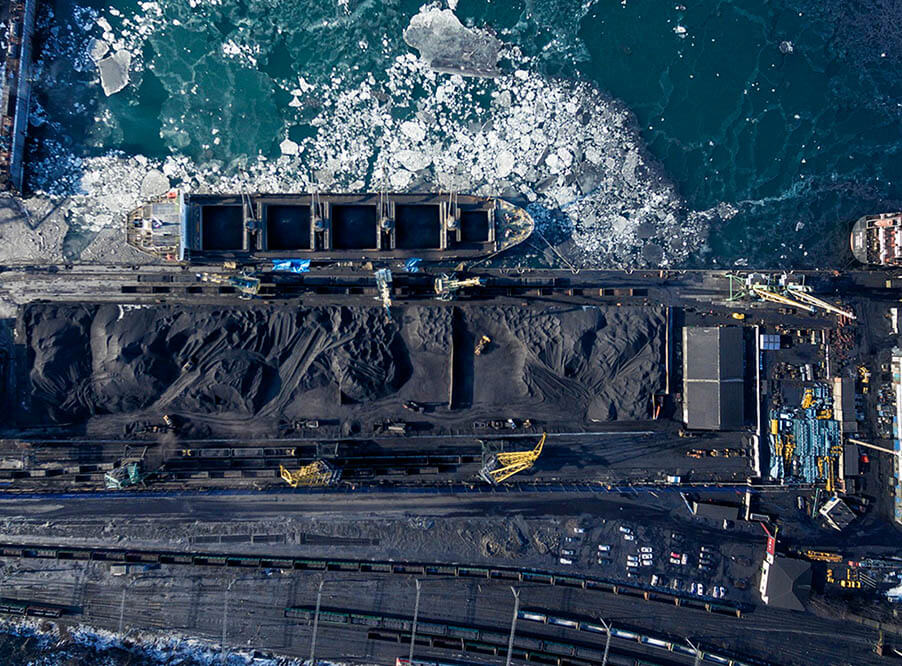CAPE ASTAFYEV is the eastern cape at the entrance to the Nakhodka Bay in the Sea of Japan. Located on the Trudny Peninsula, the cape was discovered and mapped in 1859 by the Russian corvette Amerika (“America”), and named after its navigator, Yakov Astafyev. In the area of Cape Astafyev are the Astafyev neighborhood of Nakhodka city with Astafyev Street, the Cape Astafyev terminal railroad station, and the terminals of the commercial port, including the Astafyev Terminal.
The Cape Astafyev (“Mys Astafyeva”) station is the terminal station on a railroad line in the Russian Far East. The station is located in the town of Nakhodka in Primorsky Kray. The main cargoes are ferrous metals and coal. The latter makes about 75 percent of all cargoes transported along the Trans-Siberian Railway in the eastern direction. The average daily discharge rate at the Cape Astafyev Export part of the station in 2009 and in 2017 was 280 cars and 392 cars, respectively.
Pfoto: +1
Nakhodka Commercial Sea Port (NCSP), owned by the EVRAZ Group, is a stevedoring company and the largest operator of the Port of Nakhodka. NCSP is export-oriented and handles ferrous metals, produced by the EVRAZ-owned metallurgical companies, and coal. In 2019, the volume of coal transshipment was 9.5 mln tons.
Nakhodka’s second largest stevedoring company in terms of transshipment volumes is the Astafyev Terminal company that specializes in the transshipment of bulk cargo. Founded in 2011, the company transshipped 2.9 and 3.2 million tons of coal in 2019 and in 2020, respectively. The company is headquartered in Nakhodka.
Other companies engaged in coal transshipment are Attis Enterprise (1.4 million tons in 2019), Dalmormontazh (1 million tons), the East Gate Port – Primorsky Plant (0.7 million tons), Geomar (0.28 million tons), Port Livadia (0.26 million tons), and Nakhodka Sea Fish Port (4,000 tons). In 2019, the Port of Nakhodka handled 16.1 million tons of coal out of 60.7 million tons exported through the ports in the Russian Far East. Nakhodka ranks second in coal exports after Vostochny Port, which in 2019 handled 34.9 million tons.
ECOLOGICAL SITUATION IN THE CITY OF NAKHODKA
The city of Nakhodka is located in Primorsky Kray of Russia on the Trudny Peninsula jutting into the Nakhodka Bay of the Sea of Japan, about 85 kilometers (53 mi) east of Vladivostok, the administrative center of the region. The city is cut off from the sea by the port area. With the population of 142,000 people (as of 2021), Nakhodka is the third largest city of Primorsky Kray. Since 1992, when the population peaked at 166,000, it has been steadily declining.
The city is an ecological disaster area. In recent years, there has been an increase in respiratory and oncological diseases, and in the death rate. The reason for this is that the port had handled timber and fish until 2007 when it started handling coal. This is a consequence of the change in the structure of the Russian economy in favor of the export of energy resources and low-value semi-finished products. In 2018, President Putin set the goal of increasing annual coal exports to Asia Pacific and India through Russia’s eastern ports from 60 million tons to at least 100 million tons by 2025. Given the current state of the coal terminals, such a dramatic increase will likely make the port cities of the Russian Far East uninhabitable.
Since Nakhodka’s residential neighborhoods are directly adjacent to the industrial zone and there is virtually no sanitary protection zone, the residents suffer heavily from air pollution by coal dust. This is due to the conditions of storing coal in open areas along the coastline. Since over time coal becomes denser, it heats up and starts burning. The cheapest way to prevent fires is to use a bulldozer to move the coal from one place to another, which results in the emission of large amounts of coal dust into the atmosphere. The residents of the Cape Astafyev neighborhood, whose houses are located 100 to 200 meters from the port, suffer most. The need to crush coal frozen during transportation in winter, without which it is impossible to unload it, also contributes to dust formation.
Pollution of the sea and the adjacent coast with coal has a catastrophic effect on marine fauna. For example, the number of anomalies among mussels in the Nakhodka Bay is about 90 percent. Heavy metals pollute the waters of the Nakhodka Bay and the mouth of the Partizanskaya River. Abnormal contents of zinc, chromium, cobalt, iron, and nickel are concentrated at the berths of the East Gate Port – Primorsky Plant in the Nakhodka Bay.
The only way to avoid negative consequences for the environment and public health from coal is to construct closed terminals for storage and transshipment of coal (a similar project is being implemented in the Latvian port of Ventspils). However, this would increase the cost of exporting raw materials from the country and, consequently, would reduce the profits of coal mining companies, owned by oligarchs, as well as the under the table income of corrupt officials affiliated with them.
The practice of environmental genocide against the population of Nakhodka has continued for two decades. Sanitary protection zones have not been established, as this would require the relocation of tens of thousands of people. Measures to prevent dust pollution of the atmosphere are not carried out properly, therefore the amount of coal dust in the air continues to increase. In winter, toxic black snow blankets the city. When snow falls, coal dust—that you do not see the rest of the year—becomes visible.
VIOLATIONS OF COAL STORAGE AND LOADING TECHNOLOGIES
One of the factors determining the negative impact of coal transportation on the environment is the ever increasing volume of coal handled by the Port of Nakhodka, which was not initially envisioned by the design. Since the actual areas and heights of coal piles exceed the stipulated standards, regular means of suppressing coal dust—water guns, wind shields, and canopies to protect against coal spillage into the water—are not effective.
In 2019, Rosprirodnadzor (the Russian Federal Service for Supervision of Natural Resources) stated that the stevedoring companies operating in Nakhodka were not complying with environmental safety standards. The previously approved standards for maximum allowable emissions for the Astafyev Terminal and the East Gate Port – Primorsky Plant companies were terminated.
The supervisory agency expressed its intention to reconsider the permits of the stevedoring companies working in the port, but no consequences followed. Officials were content with promises from the companies to step up their efforts to prevent further dust pollution.
Although in recent years Rosprirodnadzor has found numerous violations of environmental standards, the agency keeps assuring the public that the companies operating in the port are under its constant control. However, there is no available information on any measures taken against the violators. For example, in 2016, an inspection found that NCSP (Evraz Group) and the Astafyev Terminal had no treatment facilities for household and storm water discharged into the Nakhodka Bay. In 2020, according to the government-run TV channels, work on the construction of treatment facilities was still in progress. The date of their completion was not announced.
The same applies to the construction of a fully enclosed canopy over the unloading area of the railroad at the berths of the Astafyev Terminal, which was scheduled to be completed in 2021. Currently, open coal transshipment continues. Government supervision agencies do not take any effective measures to force the stevedoring companies to comply with environmental safety requirements. Such measures may include administrative suspension of all company’s activities and disqualification of company managers. The public is not provided with any information about either the extent of the violations or sanctions against the violators, which suggests that no such sanctions exist.
The Russian system for monitoring the impact of industrial companies on the environment works in such a way that the polluters monitor themselves. This naturally leads to a lack of any control. For example, in July 2021, Rosprirodnadzor found that the Port of Nakhodka calculated maximum permissible levels for pollutants in the air on the basis of unreliable data, and that emission values were determined using incorrect methods. As a result of such calculations, the identified violations were negligible. Had it not been for the inspection, the polluters would not have been punished in any way.
It is not possible to determine the amount of environmental damage due to the lack of reliable data on the volume of emissions. The government does nothing to change the existing system of control over harmful emissions, thus encouraging polluters to ignore industrial safety standards.
ECONOMIC FEASIBILITY OF COAL TRANSSHIPMENT FOR NAKHODKA
According to the Ministry of Economy of Primorsky Kray, in 2019 the stevedoring companies that transship coal paid to the budgets of all levels about 13.9 billion rubles (USD 185.3 million). Of these, 3.38 billion rubles (USD 45.1 million) went to social insurance funds, 7.64 billion rubles (USD 101.8 million) remained in the regional budget, 2.62 billion rubles (USD 34.9 million) went to the federal budget, and only about 263 million rubles (USD 3.5 million) was added to local municipal budgets. Thus, the port cities, which directly suffer from the negative consequences caused by the transportation and handling of coal, bring local budgets 4 rubles 30 kopecks (USD 0.06) per ton.
PUBLIC PROTESTS. There are no large-scale public protests against the stevedoring companies in Nakhodka. The environmental movement is split due both to the politicization of the agenda (the Communist Party, for example, often uses anti-coal rhetoric in bargaining with the regional authorities) and to the destructive position of some radical environmentalists who demand a complete ban on any coal operations in the ports of the Russian Far East. As for the latter, a reasonable strategy seems to be the construction of coal ports equipped with closed terminals and belt loaders, which would minimize the negative impact on the environment.
As a result, public discontent does not result in any large-scale protests. The most notable anti-coal rally in April 2018 brought together about 100 participants. Street protests of a similar scale took place in February 2017.
@blackmark_en – in Russian
Follow us:
Telegram in Russian
Telegram in English
Facebook in Russian
Facebook in English
Instagram in Russian
Instagram in English











